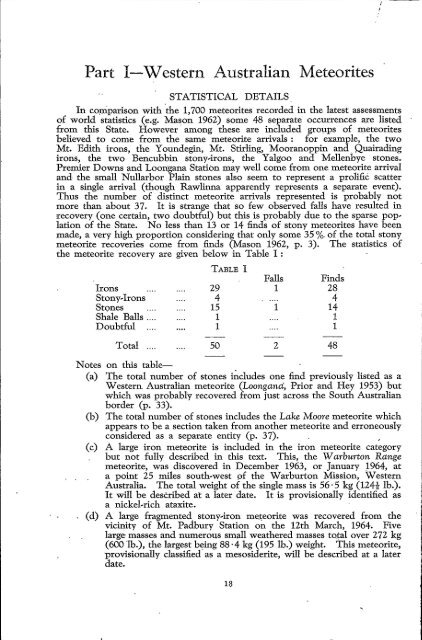catalogue of western australian meteorite collections
catalogue of western australian meteorite collections
catalogue of western australian meteorite collections
You also want an ePaper? Increase the reach of your titles
YUMPU automatically turns print PDFs into web optimized ePapers that Google loves.
I<br />
I<br />
Part I-Western Australian Meteorites<br />
STATISTICAL DETAILS<br />
In cO)llpanson with 'the 1,700 <strong>meteorite</strong>s recorded in the latest assessments<br />
<strong>of</strong> world statistics (e.g. Mason 1962) some 48 separate occurrences are listed<br />
from this State. However' among these are included groups <strong>of</strong> <strong>meteorite</strong>s<br />
believed to come from the same <strong>meteorite</strong> arrivals: for example, the two<br />
Mt. Edith irons, the Youndegin, Mt. Stirling, Mooranoppin and, Quairading<br />
irons, the two Bencubbin stony-irons, the Yalgoo and Mellenbye stones.<br />
Premier Downs and Loongana Station may well come from one <strong>meteorite</strong> arrival<br />
and the small Nullarbor Plain stones also seem to represent a prolific scatter<br />
in a single arrival (though Rawlinna apparently represents a separate event).<br />
Thus the number <strong>of</strong> distinct <strong>meteorite</strong> arrivals represented is probably not<br />
more than about 37. It is strange that so few observed falls have resulted in<br />
recovery (one certain, two doubtful) but this is probably due to the sparse poplation<br />
<strong>of</strong> the State. No less than 13 or 14 finds <strong>of</strong> stony <strong>meteorite</strong>s have been<br />
made, a very high proportion considering that only some 35 %' <strong>of</strong> the total stony<br />
<strong>meteorite</strong> recoveries come from finds (Mason 1962, p. 3). The statistics <strong>of</strong><br />
the <strong>meteorite</strong> recovery are given below in Table 1 :<br />
Irons 29<br />
Stony-Irons<br />
Stones<br />
4<br />
15<br />
Shale Balls ",. 1<br />
Doubtful 1<br />
TABLE 1<br />
Falls Finds<br />
1 28<br />
4<br />
1 14<br />
1<br />
1<br />
Total 50<br />
2 48<br />
Notes on this table-<br />
(a) The total number <strong>of</strong> stones i~cludes one find previously listed as a<br />
Western, Australian <strong>meteorite</strong> (Loongana~ Prior and Hey 1953) but<br />
which was probably recovered from just across the South Australian<br />
border (p. 33).<br />
(b) The total number <strong>of</strong> stones includes the Lake Moore <strong>meteorite</strong> which<br />
appears to be a section taken from another ~eteorite and erroneously<br />
considered as a separate entity (p. 37). .<br />
(c) A large iron <strong>meteorite</strong> is included in the iron <strong>meteorite</strong> category<br />
but not fully described in this text. This, the Warburton Range<br />
<strong>meteorite</strong>, was discovered in December 1963, or January 1964, at<br />
a point 25 miles south-west pf the Warburton Mission, Western<br />
Australia. The total weight <strong>of</strong> the single mass is 56·5 kg (124! lb.).<br />
It will be described at a later date. It is provisionally identified as<br />
a nickel-rich ataxite.<br />
. (d) A large fragmented stony-iron me~eorite was recovered from the<br />
vicinity <strong>of</strong> Mt. Padbury Station on the 12th March, 1964. Five<br />
large masses and numerOllS small weathered masses total over 272 kg<br />
(600 lb.), the largest being 88·4 kg (195 lb.) weight. This <strong>meteorite</strong>,<br />
provisionally classified as a mesosiderite, will be described at a later<br />
date.<br />
18
















